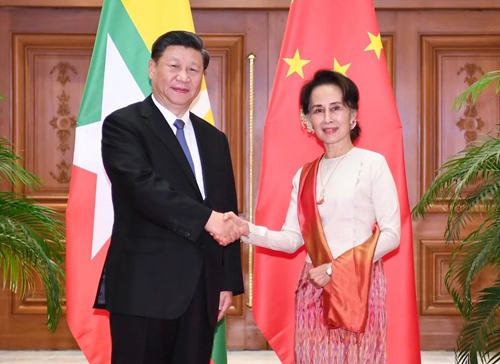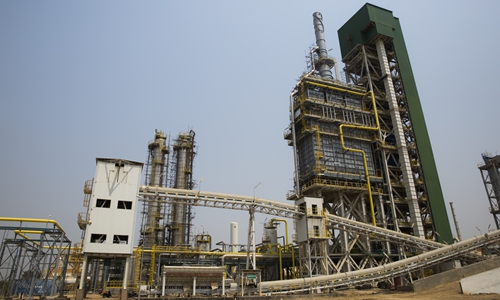HOME >> CHINA,SPECIAL-COVERAGE
Xi’s visit brings China-Myanmar ties to new era
By Li Xuanmin in Naypyidaw and Liu Xin, Zhang Hongpei in Beijing Source:Global Times Published: 2020/1/18 20:33:40
Cooperation agreements signed

Chinese President Xi Jinping and Myanmar State Counsellor Aung San Suu Kyi shake hands in Nay Pyi Taw, Myanmar on Saturday. Photo: Xinhua
Mutual respect and trust as well as the two countries' focus on economic development will elevate bilateral cooperation to a higher level, experts said.
During the visit, a number of agreements in sectors including politics, trade and investment, people-to-people exchanges and regional cooperation were signed between Chinese and Myanmar companies, witnessed by Xi, the Xinhua News Agency reported.
A joint statement issued by China and Myanmar on Saturday said China is willing to offer assistance to Myanmar to improve the settlement conditions for those repatriated who fled from social upheaval in Rakhine State to Bangladesh. Myanmar reiterated it will receive these people based on a bilateral treaty with Bangladesh.
China firmly supports Myanmar in pursuing a development path suited to its own national conditions and its efforts in upholding development and stability. Meanwhile, Myanmar expressed its support for the one-China policy, the statement said.
China's support and respect for Myanmar on its stance on the Rakhine State is in accordance with China's practices of pushing forward its own and the international community's human rights development. It could also help improve the human rights development in Myanmar and is beneficial to the stability and development of the Southeast Asian region, Qian Jinyu, executive dean of the Human Rights Institution of Northwest University of Political Science and Law in Shaanxi Province, told the Global Times on Saturday.
China and Myanmar are two countries that have complex ethnic and religious situations. How to effectively protect people's rights and promote human rights development are their core concerns. For these developing countries, the way they chose to promote human rights and social development depends on how to bring happiness to the people, Qian noted.
It is one-sided and narrow-minded for some Western countries to criticize China for "trading" supporting Myanmar on its policies to deal with the situation in Rakhine State for Myanmar's support on China's policies in its Xinjiang Uygur Autonomous Region and the Tibet Autonomous Region, Qian said.

A power plant in Mandalay uses natural gas supplied by the China-Myanmar Crude Oil &Gas Pipeline Project to generate electricity. Photo: Courtesy of CNPC
BRI opportunities
Xi and Myanmar State Counselor Aung San Suu Kyi announced China and Myanmar agreed to work together to build a community with a shared future during their formal talks in the Myanmar capital of Naypyidaw on Saturday.
Xi arrived Friday for the state visit to the Asian neighbor amid the two countries' celebration of the 70th anniversary of the establishment of diplomatic ties. It is the first visit to Myanmar by a Chinese president in 19 years.
China and Myanmar forged ahead closer economic cooperation under the Belt and Road Initiative (BRI) during Xi's visit.
The signing of cooperative agreements marks a significant step in translating the China-Myanmar Economic Corridor (CMEC) from a concept into a substantive planning and construction period within the framework of jointly building the BRI.
CMEC is the priority in bilateral cooperation under the BRI and is expected that the sense of gain of people in the two countries, especially in Myanmar, will be improved as soon as possible, the statement said.
Both countries have agreed to unleash the role of Kyaukphyu port in promoting the building of CMEC, which also includes a special economic zone on the border and a new city project in Yangon. Infrastructure connectivity projects like highways and railways will also step up construction.
Chang Zhenming, chairman of CITIC, the Chinese company which leads a consortium in developing the port project, told the Global Times Saturday that it aims to build the deep-sea port into one of the largest and most efficient container ports in Asia to serve as a gateway for Myanmar and ASEAN countries to India, Africa and the Middle East.
It is estimated that the project will bring $15 billion in tax revenue to the Myanmar government during the concession period and provide 100,000 jobs for locals every year, Chang said.
CMEC will embrace a new development phase at a faster pace, and the key CMEC projects will play a demonstration and supporting role in the further construction of the Bangladesh, China, India and Myanmar-Economic Corridor (BCIM EC) that covers nearly 3 billion people, experts noted.
Xu Liping, director of the Center for Southeast Asian Studies at the Chinese Academy of Social Sciences, told the Global Times Saturday that given the full preparation, such as feasibility studies and authentication on the BRI projects, it is expected that their implementation will be on a faster track.

People visit the Shwedagon Pagoda during the Myanmar's traditional Thadingyut lantern festival in Yangon, Myanmar, Oct. 24, 2018. The Thadingyut lantern festival is held on the full moon day of the Burmese Lunar month of Thadingyut. Myanmar people used to hold ceremonies to pay respect to the elder people with gifts. (Xinhua/U Aung)
As some Western media have portrayed the BRI projects as a geopolitical strategy to advance China's interests in Myanmar, and Indian media also claim that China is posing "a grave challenge" to India's security due to the closer ties between China and Myanmar, experts refuted such "narrow-minded ideas."
"They are worried too much. Myanmar has a key strategic position, but it does not make any sense to interpret the closer ties between China and Myanmar as the China's strategic cashing in," Xu said.
Xu noted that the two countries' advancing cooperation is based on the need of their peoples instead of any geopolitical interest, and they share a common pursuit in economic development, which is likened to a lubricant in bilateral ties.
As uncertainties remain and are likely to increase for the global economy in 2020, a stronger partnership between China and Myanmar will help stabilize and improve the regional economy, he added.
Qian Feng, a research fellow at the national strategy institute of Tsinghua University in Beijing, told the Global Times Saturday that in the South Asian and Southeast Asian regions, the China-proposed BRI shares a vision with India's 'Look East' policy, both driving the connectivity in the region.
"As China-India relations have entered a new phase of sound and stable development in recent years, it is expected that the two Asian powers will join hands in regional development," Qian said.
Myanmar officials and analysts, who have touched on the real benefits of BRI projects, refuted Western attempts to tarnish the BRI.
U Ko Ko Hlaing, co-founder of the Myanmar Institute of Strategic and International Studies, told the Global Times that for Myanmar, closer ties with China address the local infrastructure shortage, create jobs and improve locals' livelihood.
Myanmar could also serve as a strategic gateway for China to the South Asian market and Indian Ocean. Infrastructure connectivity between the two nations will also boost the development of Southwest China's Yunnan Province and Sichuan Province.
Posted in: DIPLOMACY,FOCUS